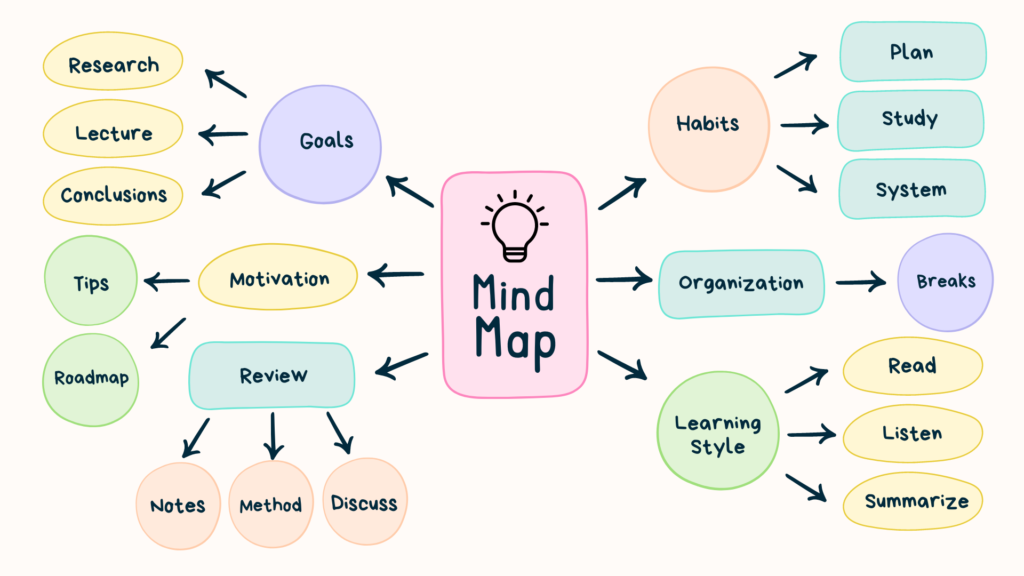Discover the transformative power of mind mapping—a remarkable technique that empowers you to visually arrange your thoughts and ideas, fostering a sense of structure and comprehensiveness in your problem-solving endeavors, strategic planning, and creative brainstorming sessions. Whether you’re embarking on your first mind mapping journey or seeking to elevate your existing skills, this article is your trusted companion, providing invaluable guidance to help you master the art of crafting impactful mind maps. Embark on this exciting adventure and uncover a world of unlimited possibilities as we delve into the tips and techniques that unlock the boundless potential of this versatile tool.
Start with a Central Idea
To create a mind map, begin with a central idea or topic that represents the main focus of your map. This central idea serves as the anchor for all the subsequent branches and sub-branches. Place it at the center of your canvas or paper and ensure it stands out visually.
Use Keywords and Short Phrases
When adding branches and sub-branches to your mind map, use concise keywords and short phrases instead of full sentences. This approach allows for better readability and clarity. Focus on capturing the core essence of each concept or idea, using keywords that trigger associations and connections.
Utilize Colors and Symbols
Adding colors and symbols to your mind map can enhance its visual appeal and aid in information retention. Assign different colors to different branches or categories to create a visual hierarchy. Additionally, consider using symbols or icons to represent key ideas or concepts, making them easily identifiable and memorable.
Connect Ideas with Lines
As you develop your mind map, draw lines or connectors to establish relationships between ideas and concepts. These lines represent the connections and associations between various elements in your map. They help create a flow and show how different ideas interconnect.
Embrace Creativity and Flexibility
Mind maps are meant to encourage creative thinking and free association. Embrace your creativity and let your thoughts flow freely. Don’t worry about following a rigid structure or conforming to traditional norms. Allow yourself to explore different paths and make adjustments as needed.
Customize Based on Your Preferences
One of the great advantages of mind mapping is its flexibility. Tailor your mind maps to suit your preferences and working style. Experiment with different layouts, color schemes, and structures to find what resonates with you. Remember, there’s no one-size-fits-all approach to mind mapping.
Practice Mindful Revision and Refinement
After creating a mind map, take the time to review and refine it. Mindful revision allows you to fine-tune your map, ensuring it accurately represents your thoughts and ideas. Add additional branches, reorganize information, and make adjustments as necessary to create a comprehensive and coherent map.
Incorporate Visual Elements
While keywords and short phrases form the backbone of a mind map, don’t hesitate to incorporate visual elements such as images, icons, or sketches. Visual cues can stimulate your imagination, trigger associations, and add a layer of creativity to your mind map.
Experiment with Digital Mind Mapping Tools
Digital mind mapping tools offer a range of features and functionalities that can enhance your mind mapping experience. Explore popular tools like MindMeister, XMind, or Coggle, which provide a digital canvas for creating and organizing mind maps. These tools offer the ability to collaborate, customize layouts, and easily edit and share your mind maps.
Share and Reflect
Finally, remember that mind maps are not static entities. Share your mind maps with others to gather feedback, gain new insights, and foster collaboration. Additionally, take the time to reflect on your mind maps and revisit them periodically to refresh your understanding and spark new ideas.
By employing these tips and techniques, you can create mind maps that unlock your creativity, boost productivity, and help you gain a deeper understanding of complex topics. Stay tuned for our upcoming blog posts, where we’ll explore more aspects of mind mapping and its applications.
Read more on Mind Mapping
THE BENEFITS OF DIGITAL MIND MAPPING TOOLS VS. HAND-DRAWN MIND MAPS
HOW TO USE MIND MAPS FOR STUDYING AND LEARNING
THE SCIENCE OF MIND MAPPING: HOW IT WORKS AND WHY IT’S EFFECTIVE
HOW TO USE MIND MAPS FOR PROBLEM-SOLVING AND DECISION-MAKING
FAQs
-
- Are there any recommended mind mapping software for beginners? Yes, there are several user-friendly mind mapping software options suitable for beginners, such as MindMeister, XMind, and SimpleMind. These tools provide intuitive interfaces and helpful features to get you started on your mind mapping journey.
-
- Can I create mind maps using pen and paper? Absolutely! Pen and paper are excellent tools for creating mind maps. They offer a tangible and tactile experience, allowing for a deeper connection with your thoughts and ideas. Many individuals prefer the simplicity and freedom of sketching mind maps by hand.
-
- How can mind mapping improve my brainstorming sessions? Mind mapping is highly effective in facilitating brainstorming sessions. It encourages free-flowing idea generation and helps visualize the connections between different concepts. By using mind maps during brainstorming, you can enhance creativity, explore new possibilities, and capture a wide range of ideas.
-
- Can I use mind mapping for note-taking and studying? Absolutely! Mind mapping is an excellent technique for note-taking and studying. It provides a visually organized structure that enhances information retention and comprehension. By creating mind maps of lecture notes or study materials, you can condense complex information into easily digestible visuals.
-
- Are there any specific mind mapping techniques for project management? Yes, mind mapping can be a valuable tool for project management. Techniques such as the “Tree Structure,” “Radial Map,” or “Timeline Map” can help you plan and track project milestones, tasks, and dependencies. Mind maps provide a holistic view of the project and facilitate effective communication among team members







